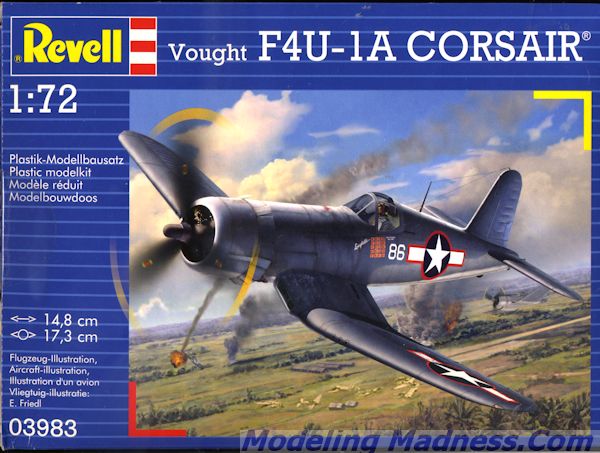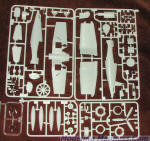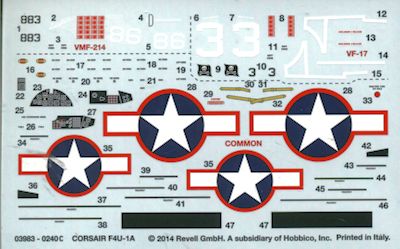
Revell AG 1/72 F4U-1A Corsair
| KIT #: | 03983 |
| PRICE: | $14.95 SRP |
| DECALS: | Two options |
| REVIEWER: | Scott Van Aken |
| NOTES: | New tool kit |

| HISTORY |
F4U-1A (Corsair Mk II): The designation F4U-1A does not appear in lists of Corsair Bureau Numbers and was not officially used, being applied post-war to differentiate mid-to-late production F4U-1s from the early production variant. Mid-to-late production Corsairs incorporated a new, taller and wider clear-view canopy with only two frames, along with a simplified clear view windscreen; the new canopy design meant that the Plexiglas rear-view windows could be omitted. The pilot's seat was raised 7 in (180 mm) which, combined with the new canopy and a lengthened tailwheel strut, allowed the pilot better visibility over the long nose. In addition to these changes the clear view panels under the cockpit were also omitted. These Corsairs introduced a 6 in (150 mm)-long stall strip just outboard of the gun ports on the starboard wing leading edge and improved undercarriage oleo struts which eliminated bouncing on landing, making these the first "carrier capable" F4Us. F4U-1s supplied to the USMC lacked arrester hooks and had a pneumatic tail wheel, instead of the smaller diameter solid rubber type used for carrier operations. Additionally, an experimental R-2800-8W engine with water injection was fitted on one of the late F4U-1As. After satisfactory results, many F4U-1As were fitted with the new powerplant. The aircraft carried 237 gal (897 l) in the main fuel tank, located in front of the cockpit, as well as an unarmored, non-self-sealing 62 gal (235 l) fuel tank in each wing. This version of the Corsair was the first to be able to carry a drop tank under the center-section. With drop tanks fitted, the fighter had a maximum ferry range of just over 1,500 mi (2,400 km).
A land-based version, without the folding wing capability, was built by Goodyear as the FG-1A. In British service, the aircraft type was modified with "clipped" wings (8 in (200 mm) was cut off each wingtip) for use on British aircraft carriers, under the designation Corsair Mk II.
| THE KIT |
 This
kit asks the question; "Do we need another 1/72 Corsair"? Well, apparently
Revell AG thinks so as this very much looks like a new tool kit. The only thing
I can figure out regarding the 'need' to spend the $$ on a kit like this is that
the superlative Tamiya kit is too expensive in Europe and Revell thinks this one
will take the place of that kit on the shelves of buyers. Checking various
sources, I found that in the US, the Tamiya kit retails for $27.00, but can be
bought for $15.50, shipping included. That is 55 cents more than retail for the
Revell kit before taxes.
This
kit asks the question; "Do we need another 1/72 Corsair"? Well, apparently
Revell AG thinks so as this very much looks like a new tool kit. The only thing
I can figure out regarding the 'need' to spend the $$ on a kit like this is that
the superlative Tamiya kit is too expensive in Europe and Revell thinks this one
will take the place of that kit on the shelves of buyers. Checking various
sources, I found that in the US, the Tamiya kit retails for $27.00, but can be
bought for $15.50, shipping included. That is 55 cents more than retail for the
Revell kit before taxes.
With the preamble out of the way, let us take a look at what Revell AG provides. First off, there are four white and one clear sprue of plastic. The molding is very good (as it should be on a new kit), and there are a lot of parts, some of which I thought might be unnecessary.
Beginning in the cockpit, which is the norm for previews, you get a forward and rear bulkhead, a floor section that is open and includes a trough under it for the separate control stick. Rudder pedals are provided for the forward bulkhead piece and the seat fits on a block under it on the floor section. In reality, it is attached to the rear bulkhead. There are also side consoles provided to fit into each fuselage half. So pretty complete, I'd say.
Moving to the wings, these have a one-piece lower section, two wing upper sections, separate wing tips, and inserts for the leading edge radiators. Also separate are the wing gun inserts. Apparently Revell is thinking of a cannon armed version later. There is fabric detail on the tops and bottoms of the outer wings. The fin is a separate piece as is the rudder. One is provided with an engine that has a full bank for the front and a half bank for the rear. Both oopen and closed cowl flap options are provided. The cowling consists of an upper and lower half with a complete forward section. Exhaust are separate as is the upper forward fuselage, the first time I have seen this on a Corsair kit.
All of the landing gear doors are molded closed so have to be cut open. The main wheels have a separate rear wheel insert piece and convincingly complex main and tail gear units. The tail wheel is molded in place and is the small hard version used on the carrier instead of the pneumatic one purported by Wiki for use on land based Marine units. Interestingly, the kit does not provide a centerline fuel tank, but two small pylons on the inside of the lower wing next to the fuselage to hold two smaller tanks. I am not sure if these are appropriate for the 1A or not so I'll let Corsair enthusiasts discuss that one. A separate windscreen and canopy are given so the canopy can be posed open. Both are quite thin.
 Instructions
are typical of Revell and are well drawn. All color references are in Revell
paints. All the exterior and interior colors will need to be mixed (even the
white as Revell wants you to add some grey) as apparently Revell has not decided
to formulate paint for USN tri-color paint schemes or standard US interior
green. Markings are for two planes, each with red surround insignia. One is the
box art plane that was used for a photo op with Greg Boyington and apparently is
one he never flew. The other is for VF-17's #3 plane The decal sheet includes
instrument panel decals, wing walk decals and the tape for the forward upper
fuselage where the fuel tank frequently leaked so was taped up to stop this. The
decals are nicely printed.
Instructions
are typical of Revell and are well drawn. All color references are in Revell
paints. All the exterior and interior colors will need to be mixed (even the
white as Revell wants you to add some grey) as apparently Revell has not decided
to formulate paint for USN tri-color paint schemes or standard US interior
green. Markings are for two planes, each with red surround insignia. One is the
box art plane that was used for a photo op with Greg Boyington and apparently is
one he never flew. The other is for VF-17's #3 plane The decal sheet includes
instrument panel decals, wing walk decals and the tape for the forward upper
fuselage where the fuel tank frequently leaked so was taped up to stop this. The
decals are nicely printed.
| CONCLUSIONS |
So there you have it. Want a new 1/72 Corsair? Now you can have one. Whether this one is a nicer build than those offered by Tamiya or even Hasegawa will not be known until it is built. One thing for sure, it seems to have enough detail to satisfy most.
| REFERENCES |
http://en.wikipedia.org/wiki/Vought_F4U_Corsair
2014
Thanks to
me for picking up the preview kit. If you would like your product reviewed fairly and
fairly quickly, please
contact
the editor or see other details in the
Note to
Contributors.